Main Alter
a:5:{s:11:”maps_images”;s:71:”http://www.stpatricklowell.org/wp-content/uploads/2018/12/floorplan.jpg”;s:10:”pins_image”;s:71:”http://www.stpatricklowell.org/wp-content/uploads/2018/12/churchpin.png”;s:16:”pins_image_hover”;s:0:””;s:16:”pins_more_option”;a:6:{s:8:”position”;s:13:”center_center”;s:10:”custom_top”;s:4:”12.5″;s:11:”custom_left”;s:4:”13.5″;s:16:”custom_hover_top”;s:1:”0″;s:17:”custom_hover_left”;s:1:”0″;s:14:”pins_animation”;s:5:”pulse”;}s:11:”data_points”;a:9:{i:0;a:10:{s:7:”content”;s:669:”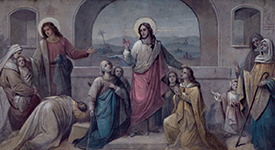
Murals
Twenty four murals line the church walls and depict the life of Christ. Famed artist Gustav Kinkelin of Munich took six months to complete the task. The murals were recently lovingly restored by the John Canning Company during a comprehensive historic restoration and conservation of St. Patrick’s interior.
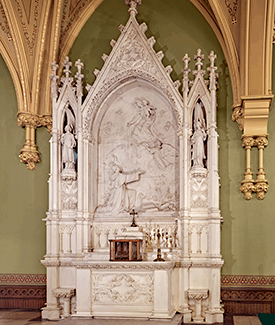
Side Altars
The marble altar to the left of the main altar shows Mary giving scapular to Saint Dominic (dog with a torch in mouth is symbol of Dominicans). The marble altar to the right of the main altar depicts Saint Margaret Mary receiving vision of the Sacred Heart.“;s:8:”linkpins”;s:0:””;s:11:”link_target”;s:5:”_self”;s:17:”pins_image_custom”;s:0:””;s:23:”pins_image_hover_custom”;s:0:””;s:9:”placement”;s:1:”n”;s:7:”pins_id”;s:0:””;s:10:”pins_class”;s:0:””;s:3:”top”;s:5:”11.85″;s:4:”left”;s:5:”18.31″;}i:2;a:10:{s:7:”content”;s:808:”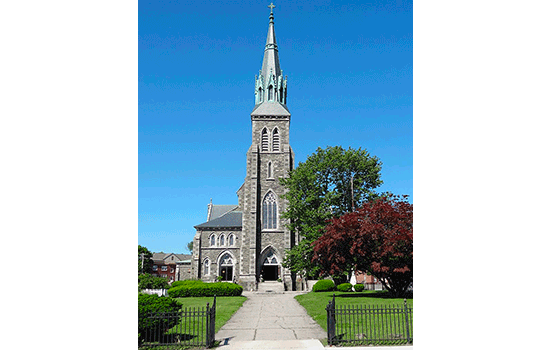
St. Patrick Lowell Exterior
St. Patrick Church is an outstanding example of a thirteenth century Romanesque styled church, designed by famed architect Patrick Keely. The 1854 granite church suffered a devastating fire on the morning of January 11, 1904. The structure remained intact, but interior of the church was in ruins. The church recently underwent a complete structural and aesthetic restoration, preparing it to serve future generations of God’s people.“;s:8:”linkpins”;s:0:””;s:11:”link_target”;s:5:”_self”;s:17:”pins_image_custom”;s:0:””;s:23:”pins_image_hover_custom”;s:0:””;s:9:”placement”;s:1:”n”;s:7:”pins_id”;s:0:””;s:10:”pins_class”;s:0:””;s:3:”top”;s:5:”87.55″;s:4:”left”;s:5:”49.71″;}i:3;a:10:{s:7:”content”;s:2116:”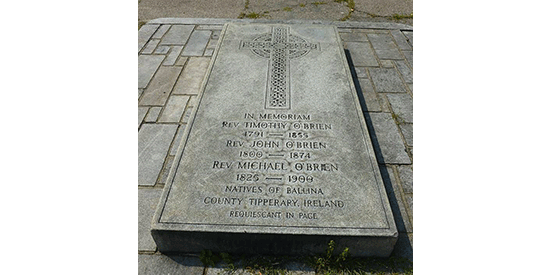
O’Brien Tomb
In front of the church under the granite slab engraved with a Celtic cross, lie the remains of three of the four Fathers O’Brien who comprised the O’Brien Dynasty.
The O’Brien Dynasty began with the arrival of Father John O’Brien in 1848. His older brother, Father Timothy O’Brien, joined him in 1851. It was through their combined talents that the growing Irish numbers would find identity in an increasingly anti-Irish Lowell.
Father Timothy O’Brien knew that for the Irish to reach their fullest potential and take on leadership for themselves education was essential. He continually petitioned different orders to open a school for the children of the Acre. In 1852, five Sisters of Notre Dame de Namur arrived in Lowell. In 1855, Timothy O’Brien, who is responsible for bringing Catholic education to Lowell, suffered a bought of pneumonia and died.
Father Michael O’Brien, a nephew of John and Timothy, came to assist his uncle. It was during this time that many properties were built and support societies were formed. The number of Irish grew as well. The Girls’ School added an academy for boarders. The Xaverian Brothers arrived to teach the boys. The Working Girls Home was added for those young women who wanted a secure place to room while working at the mills. The crowning glory to Father Michael’s tenure as pastor was the consecration of the church in 1874, a title not given many churches.
Father John continued to serve the people of St. Patrick’s until his death in 1879. He is perhaps best well known for Father John’s Medicine.“;s:8:”linkpins”;s:0:””;s:11:”link_target”;s:5:”_self”;s:17:”pins_image_custom”;s:0:””;s:23:”pins_image_hover_custom”;s:0:””;s:9:”placement”;s:1:”n”;s:7:”pins_id”;s:0:””;s:10:”pins_class”;s:0:””;s:3:”top”;s:5:”93.16″;s:4:”left”;s:5:”49.71″;}i:4;a:10:{s:7:”content”;s:679:”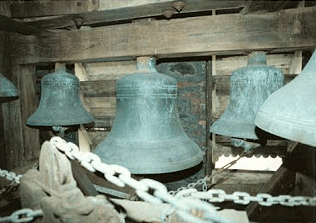
St. Patrick Bells
A set of 11 chimes, made by the Meneely Brothers of New York, is housed in the tower. Each bell was given a name inscribed into the metal and then baptized before being raised to ring out to God. The bells are played from a keyboard in the tower. The largest bell, Patrick, can also be rung by a rope at the entrance to the church.“;s:8:”linkpins”;s:0:””;s:11:”link_target”;s:5:”_self”;s:17:”pins_image_custom”;s:0:””;s:23:”pins_image_hover_custom”;s:0:””;s:9:”placement”;s:1:”n”;s:7:”pins_id”;s:0:””;s:10:”pins_class”;s:0:””;s:3:”top”;s:5:”81.33″;s:4:”left”;s:5:”50.00″;}i:5;a:10:{s:7:”content”;s:600:”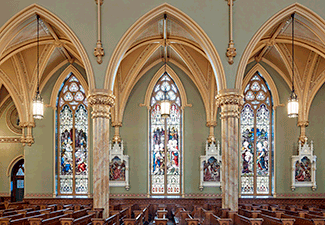
Stained Glass Windows
St. Patrick’s features 81 stained glass windows. The fifteen Bavarian style windows lining the nave tell the story of the 15 mysteries of the rosary. In the rear of the church the largest window shows Patrick teaching the chieftains at Tara.“;s:8:”linkpins”;s:0:””;s:11:”link_target”;s:5:”_self”;s:17:”pins_image_custom”;s:0:””;s:23:”pins_image_hover_custom”;s:0:””;s:9:”placement”;s:1:”n”;s:7:”pins_id”;s:0:””;s:10:”pins_class”;s:0:””;s:3:”top”;s:5:”49.80″;s:4:”left”;s:5:”19.48″;}i:6;a:10:{s:7:”content”;s:874:”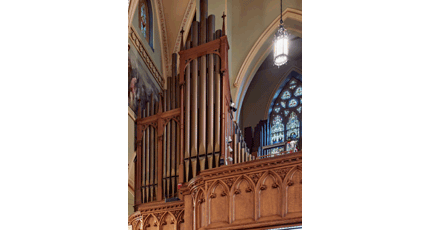
Organ
After the 1904 fire, the Jesse Woodbury Company of Boston designed and installed a new organ. Not wanting to obstruct the grand stained glass window of St. Patrick preaching to the Chieftains at Tara, Woodbury designed a divided organ with pipes separated to provide a clear view of the window. It is the largest organ built by Woodberry, and the largest surviving pipe organ in the City of Lowell. Unplayable for nearly a decade the organ is being restored by the Andover Organ Company. The restoration project should be completed in 2020.“;s:8:”linkpins”;s:0:””;s:11:”link_target”;s:5:”_self”;s:17:”pins_image_custom”;s:0:””;s:23:”pins_image_hover_custom”;s:0:””;s:9:”placement”;s:1:”n”;s:7:”pins_id”;s:0:””;s:10:”pins_class”;s:0:””;s:3:”top”;s:5:”73.69″;s:4:”left”;s:5:”49.71″;}i:7;a:10:{s:7:”content”;s:679:”
Statues
Fine-art marble sculptures by Joseph Sibbel grace the interior of the church. St. Joseph and St. Patrick sit proudly on the main altar. Above the main altar are Saints Peter and Paul (Peter is holding the keys). The four gospel writers gaze on the congregation from the left and right Matthew (Winged Man), Mark (Lion), Luke (Ox), and John (Eagle).“;s:8:”linkpins”;s:0:””;s:11:”link_target”;s:5:”_self”;s:17:”pins_image_custom”;s:0:””;s:23:”pins_image_hover_custom”;s:0:””;s:9:”placement”;s:1:”n”;s:7:”pins_id”;s:0:””;s:10:”pins_class”;s:0:””;s:3:”top”;s:4:”5.82″;s:4:”left”;s:5:”38.95″;}i:8;a:10:{s:7:”content”;s:784:”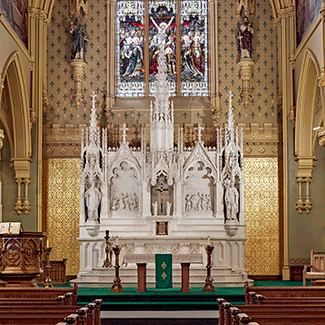
Main Altar
The ornate main altar features fine-art marble sculptures of saints, and angels, all carved by Joseph Sibbel. Sibbel’s work can also be found in St. Patrick’s Cathedral, New York City. The altar in the lower chapel is the marble altar from the 1854 church. The story goes that during the fire, the floor gave way and the altar fell into the basement just where it sits today. Extremely unlikely, but nobody alive today knows for sure.“;s:8:”linkpins”;s:0:””;s:11:”link_target”;s:5:”_self”;s:17:”pins_image_custom”;s:0:””;s:23:”pins_image_hover_custom”;s:0:””;s:9:”placement”;s:1:”n”;s:7:”pins_id”;s:0:””;s:10:”pins_class”;s:0:””;s:3:”top”;s:5:”11.65″;s:4:”left”;s:5:”49.42″;}}}
